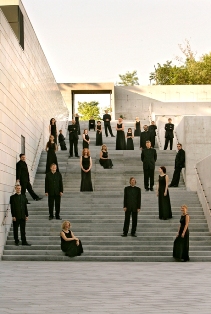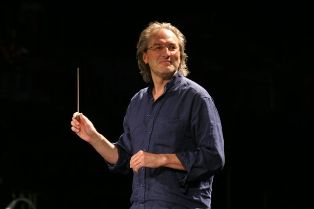
Kaljuste Brings Famed Estonian Choir to Cincinnati
McCain or Obama?

Vivaldi’s choral
work “Beatus vir” could apply to either.
That’s why Tõnu Kaljuste, founding director of the Estonian
Philharmonic Chamber Choir, picked it as one of the selections on the choir’s
current tour of the United States and Canada.
“It’s my small joke,” he said. “’Beatus vir’ is ‘blessed man.’ It’s written for two choirs and two orchestras. One orchestra is Republican, the other is Democrats. It’s a little antiphonal (the choirs alternate). A little musical clash between. Seen with these eyes, it’s fun.”
The 29-member choir, acknowledged as one of the finest in the world, performs at 7:30 p.m. Tuesday (Nov. 11) at St. Peter in Chains Cathedral, Plum and Eighth Streets in downtown Cincinnati. They will be joined by the Tallinn Chamber Orchestra. It will be the fifth stop on the groups’ three-week, 11-city tour.
In addition to the Vivaldi, the program comprises Arvo Pärt's “Wallfahrtslied” (“Pilgrim’s Song” for male choir and strings), “L’Abbe Agathon” (soprano and strings), “Da pacem Domine" (choir and strings) and “Orient Occident” (string orchestra,) and Erkki-Sven Tüür’s “Action,” “ Passion” and “Illusion” (string orchestra). The concert is part of the Cathedral’s 2008-09 “Great Music in a Great Space” series.
A native of Tallinn, Estonia, Kaljuste, 55, has
long been known as one of the world’s most distinguished choral
conductors. Son of choral conductor and educator Heino Kaljuste, he took over his father's Ellerhein
Chamber Choir in 1974 (in which he had sung as a child). In 1981, after winning first prize in the
Bela Bartok International Choral Competition in Debrecen, Hungary, including
the prize for best conductor, he reorganized it as a full-time professional
choir and renamed it the Estonian Philharmonic Chamber Choir. Under his direction, the EPCC forged an international reputation, winning acclaim on tour and for its
recordings. In 1993, Kaljuste founded the
collaborative Tallinn Chamber Orchestra (currently a 17-piece string orchestra).

The EPCC performs 60-70 concerts annually, tours regularly in Europe, North America and Asia, and has a huge repertoire, ranging from Gregorian chant to contemporary music. It has received eight Grammy nominations and won a Grammy in 2007 for Best Choral Performance (Pärt’s “Da pacem Domine” on the Harmonia Mundi label). Paul Hillier succeeded Kaljuste as chief conductor and artistic director from 2001-07. Hillier was succeeded by Daniel Reuss in September, 2008.
In 2001, after 20 years with the EPCC, Kaljuste – somewhat like Robert Shaw of the famed Robert Shaw Chorale -- shifted his focus to orchestral conducting. (During the 1990s, he was also principal conductor of the Swedish Radio and Netherlands Chamber Choirs.)
“From 2000, I’m working with orchestras mostly,” he said, by phone from Louisville where the choir and orchestra spent a free day earlier this week. In 2006, he launched the summertime Nargen Festival in Estonia, even seeing through the construction of a unique opera house – a re-constructed barn, actually -- on Naissaar, an island off Estonia’s northern coast. The latter is the subject of a 2007 Estonian documentary “Vastutuulesaal” (“Headwind Hall”) where Kaljuste sees his “impossible dream” of building an opera house on the island come true after five years of dogged effort.
Why build an opera house on a deserted island in the first place? (Naissaar had only one permanent resident, no electricity and no regular ferry service.) And why tackle the vast repertoire for orchestra after achieving world fame as a choral conductor?
Perhaps it’s the challenge, or simply the desire to seek new horizons. For the barn-as-opera-house – the original plan was for something contemporary with Sydney Opera-House appeal – Kaljuste sought “this kind of clean place where there was no information, no nothing, just from zero.” Today it is a popular summer destination for concerts, theater and opera, with ferry service from Piirita harbor in Tallinn (information at www.nargenopera.ee).
He did not start
from zero conducting orchestras, having studied choral and orchestral
conducting at the Tallinn and Leningrad Conservatories. The music is what led him on, he said.
“It’s possible, of
course, to be (a choral conductor) until the end of life and conduct all these
pieces we’ve done before, but the choir repertoire is quite limited. All the most important things I wanted to do
I had done. I moved to free lancer to be
free and to find more interesting scores and develop my repertoire in this
area. It is a wonderful life now to do
absolutely different repertoire." Since 2002,
Kaljuste has conducted the RTE National Symphony (Dublin), BBC Symphony, Budapest
Festival Orchestra, Lausanne Chamber Orchestra, Vienna Tonkünstler, Camerata Salzburg, Mahler Chamber
Orchestra, Hamburg State Opera, Oslo Philharmonic, CBC Radio Orchestra and the Radio
Orchestras of Sweden, The Netherlands, Finland, Norway, Denmark, Berlin and Munich, among others. His new all-Pärt CD with the Estonian National Orchestra is set for release by
ECM in February (“In Principio,” “La Sindone,” “Cecilia virgine romana,” “für
Lennart, “Da pacem Domine” and “Mein Weg”).
Singing and choral music are what he has spent most of his life doing, however, and as an Estonian, that is a very special thing. “It’s part of education," he said. "Every school has a children’s choir, They study music like we study vocabulary words with languages. To write music is like to write sentences, to read music, like to read newspapers. It’s an ideal, of course, but people have quite nice education.”
With hundreds of choirs through the country, singing has had an even larger meaning for tiny Estonia (population 1.4 million, about the size of Vermont and New Hampshire combined). “It’s connected with the political side. It was a weapon. With this nation you don’t have any tanks and guns. There is only culture that can hold your nation and part of that is music. Singing was important in the end of the 19th century to bring people together. 'Singing Revolution' was important in the end of the 1980s, too, in Estonia.”
The Estonian
National Song Festival was founded in 1869 and became important as part of the
country’s national awakening after 700 years of foreign rule. The “Singing Revolution” refers to Estonia’s
struggle for re-independence from the Soviet Union, a bloodless revolution
waged in large part via the national song festival. This inspiring story is told in the 2007 documentary film, “The
Singing Revolution." Screened by Cincinnati World Cinema at the Cincinnati Art
Museum in July, the film has been presented in held-over engagements at movie theaters throughout the
U.S. and has just been released on DVD (see www.singingrevolution.com). Interestingly, a chorus from Cincinnati led by the late John Leman performed at a special "Bridges of Song" festival in Tallinn in 1991 organized by Kaljuste. In an interview for The Cincinnati Post in 2006, Leman called it "one of the top five musical experiences of my life."
Kaljuste is an ardent champion of his country’s music, everything from ancient runic songs and the folk-inspired music of Veljo Tormis to Arvo Pärt and Erkki-Sven Tüür. Estonia’s choirs have made an important contribution to 20th-century music, he said. “Professional choir singing is a very young profession in the world. It has developed in the 20th century to a right level. Before this, it was mostly amateur, for fun.”
Tõnu Kaljuste conducts the Estonian Philharmonic Chamber Choir and Tallinn Chamber Orchestra in music by Vivaldi, Arvo Pärt and Erkki-Sven Tüür at 7:30 p.m. Nov. 11 at St. Peter in Chains Cathedral in Cincinnati. Tickets are $35 in advance, $38 at the door. Order online at www.stpeterinchainscathedral.org. Student and group discounts available. For information, call 513-421-2222.